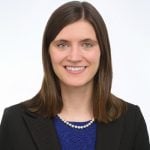In conversation
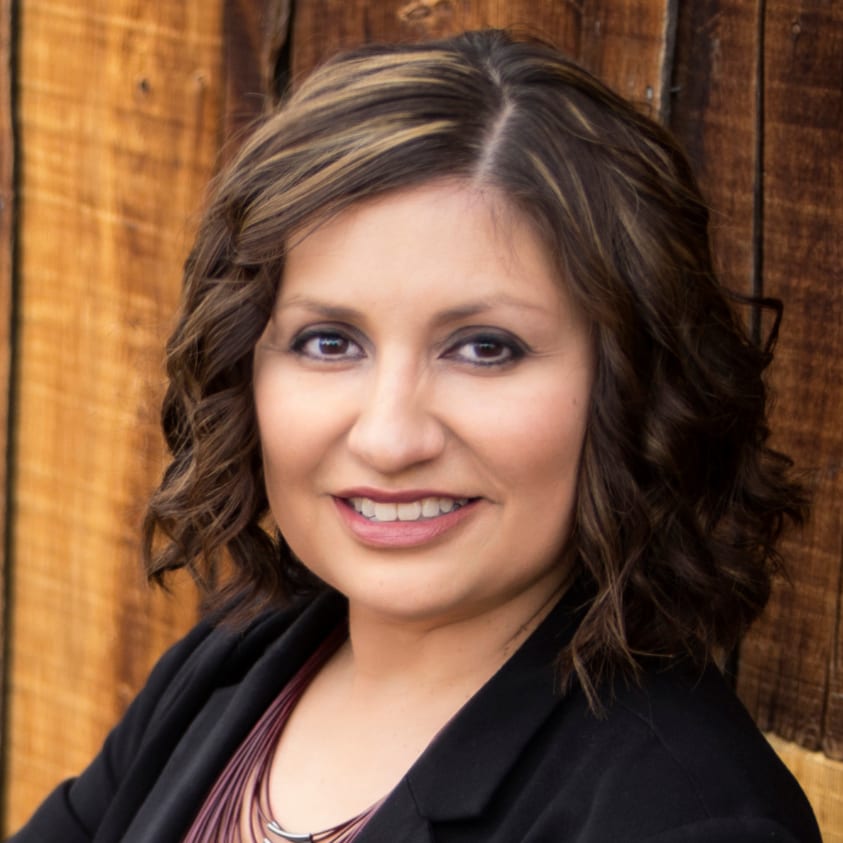 Lisandra Gonzales
Lisandra Gonzales
Chief operating officer, Rocky Mountain Partnership
Learn more about Lisandra >>
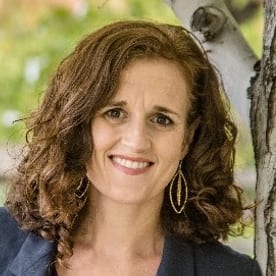 Becky Hoffman
Becky Hoffman
Chief executive officer, Rocky Mountain Partnership
Learn more about Becky >>
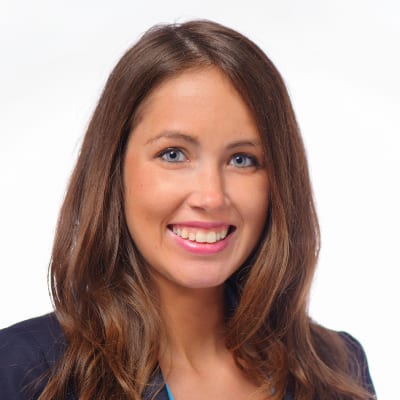 Bridget Jancarz
Bridget Jancarz
Chief of staff, StriveTogether
Learn more about Bridget >>
Host
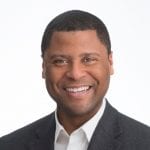 Christian Motley
Christian Motley
Senior manager of policy and partnerships, StriveTogether
Transcript
Christian Motley, senior manager of policy and partnerships, StriveTogether
[00:19] Hi, I’m Christian Motley from StriveTogether, your host of Together for Change where we shed light on what’s possible in creating an equitable recovery.
Today we will take a close look at how we StriveTogether network member applied the Theory of Action in a coordinated community response to COVID-19. Joining me from Rocky Mountain Cradle to Career are Chief Executive Officer Becky Hoffman and Chief Operating Officer Lisandra Gonzalez. Glad you could join us Becky.
Becky Hoffman, chief executive officer, Rocky Mountain Partnership
[00:45] Honored to be here with you today.
Christian Motley
[00:47] Welcome, Lisandra.
Lisandra Gonzales, chief operating officer, Rocky Mountain Partnership
[00:49] Glad to be here, Christian.
Christian Motley
[00:52] Also, StriveTogether Chief of Staff Bridget Jancarz is with us today. Hi, Bridget.
Bridget Jancarz, chief of staff, StriveTogether
[00:56] Hello, and I am so excited about this. I can’t imagine doing this with two more capable or inspiring women. So really excited about it.
Christian Motley
[01:08] Rocky Mountain Cradle to Career is one of 70 communities that make up the Cradle to Career Network, operating across 30 states and Washington, D.C. This network impacted the lives of 12 million youth last year, including more than 6 million children of color. Let’s get started. Becky, set the scene for me — describe the early days of the pandemic there in Adams County, Colorado. How’d your community come together?
Becky Hoffman
[01:33] Thank you, Christian. You know, overnight, we went from talking about middle-grade math and youth employment to the urgent, basic human needs around food, housing, insurance and safety. We went from talking about the summer slide and summer melt to the COVID slide. And although those factors have always informed our work, they became the driver literally overnight.
[01:58] The community really came together with this new, refined rally call. So, community leaders called and said, you know that outcomes-driven approach framework you’ve been dripping on us for the last eight years? We’re going to need that. And we’re going to need that now. We need your help and bringing partners together to help us not only respond, but to help us even consider what recovery is going to look like.
And so, the community came together like they were used to coming together with us, and there was this newfound urgency and fire in their belly. I will add, it also helped that our senior leaders, the one asking for this coordination and collaboration, was from our Board of County Commissioners and manager asked us to help them support them with this.
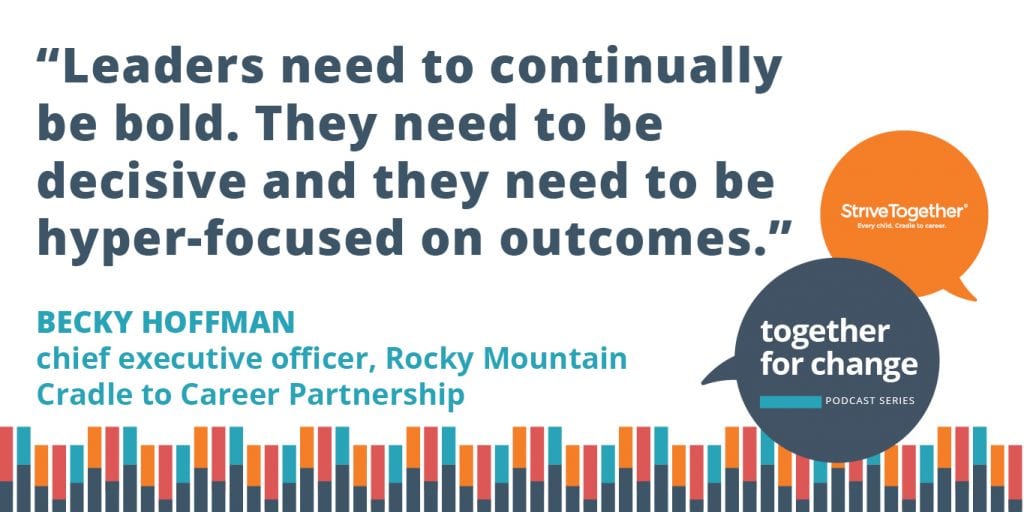
Christian Motley
[02:44] Well, I was going to add — so you’ve said that there are relationships that you all had from the, you know, from before COVID. I’m interested particularly about that relationship with the — did you say it was the county manager?
Becky Hoffman
[02:59] And the county commissioners.
I think what you’re hitting on is, this isn’t our first rodeo, right? We adopted the StriveTogether framework, the theory of action, over eight years ago. We had built the readiness in the community, buy-in was in place, and quite frankly, we were positioned for outcomes-driven work, right on the heels of COVID. So, the readiness for doing things differently and the understanding of how we were going to do that was baked in. And honestly, it wasn’t a huge lift for our team or the community to respond to this outcomes-driven approach of working together.
Lisandra Gonzales
[03:38] I’ll add that really was the only thing that we could count on as a community was this idea of we have to come together, and we have to use a rigorous approach to actually figure out what to do. Because everyone was sort of flipped on their heads in terms of panic and fear and uncertainty. And literally going back, to the only thing that we knew we could count on was that. We had no idea what the next day or the next week was going to look like. But we did know if we can pull these right people into the room, we’re better together than we are on our own.
Christian Motley
[04:09] Thank you. And we’ve talked before on this podcast just about how, just describes just what you’re saying — how many of the partnerships in the StriveTogether Network very quickly had to adapt and change the way they worked to stabilize community. What were some of the priorities that were coming up in Adams County that you knew that you had to immediately address?
Becky Hoffman
[04:32] We’re already dealing with a bit of a high poverty rate, increasing growing human homelessness rate. And so really what the opportunity was, how do we triage and make sure that we kind of put masks on literally and figuratively and ensure that we stopped the bleeding that was happening because the numbers were starting to skyrocket pretty quickly.
Our community is a blue-collar community. Therefore, our community members are the ones on the front lines and also living more individuals per household than in some of our surrounding communities. And so, the opportunity was, let’s get together, let’s triage and let’s think of what are those first few things that we need to do to kind of stabilize the response effort.
And then from there, how do we, at the same time, start to pull together the data — for example, around food security, where are the greatest needs, food needs, really spiking and where are the food hub distribution centers in relationship to that so that we can make sure that that food was being distributed as quickly as possible. That’s just an example.
Christian Motley
[05:43] Yeah. Are you similar to some other communities where the school district was doing a lot of the food distribution, or were there multiple partners you all had to coordinate?
Becky Hoffman
[05:52] I think this is a great example, is — I mean, first of all, going back pre-COVID. You know, the idea of convening over 300 partners weekly was a barrier around the logistics of just getting humans to commit. They always were bought into the work. But scheduling has always been a challenge. And all of a sudden, we’re convening and coaching over 300 partners every single week and organize them around what we refer to as seven response and recovery teams. And those were aligned to these basic needs that we were addressing in real time: food security, child care support, health care, access, housing and employment.
Imagine if 58% of the kiddos in your community are not having access to food literally overnight. For us, that equates to about 700 students who qualify for free and reduced lunch than what we were supporting our school districts who are used to serving the kids at school, that was no longer their reality. And so, what they had to do in real time was to flip to mobile delivery of food.
At the same time, we have 45 unique food banks and churches that are also providing this support. And it was really all hands on deck. But before COVID there wasn’t an organization that was waking up thinking about regional food insecurity as a whole pie. We were helping the community think about those pockets where low income and kids of color were most impacted.
[07:24] Because at the same time, the resources were coming in hot and heavy from a federal, state and local level. And instead of trying to have people make decisions in a vacuum, we were bringing those partners to the same table to say, okay, where are these 70,000 kids located, what community partners are located next to them that were historically used to serving those kiddos and then really aligning those resources that were coming in. And then also supporting our community leaders with quick calls to action around things like food waivers. It was no longer a reality that the federal government could mandate that the kids be served at school. They had to take those resources out into the community.
And so we are really proud. I mean, that’s systems change, my friends, right? We were able to change state and local policy in real time, aligned resources to the kiddos that need it most and support our community partners to be hyper-focused on that work.
Christian Motley
[08:23] See, that’s powerful, and what I also hear is just how the infrastructure that you all had built prior to COVID not only helps you to coordinate and communicate among partners, but also, there was a certain level of readiness that you had when state and federal resources came in to support those communities. You all were — the relationships are ready, you were looking at the data and the teams were coordinated, with a strategy kind of ready to go.
Lisandra Gonzales
[08:50] We give that full credit to that theory of action. And for those who don’t know what that is, it’s really the framework and infrastructure that’s the magic behind the StriveTogether national movement. There’s a rigorous approach that’s in place and it is, when implemented authentically and holistically, it really primes the community to have the systems impacts that it needs to have. And we didn’t really do anything special other than hold rigor to that framework. We adapted it in real time as needed to triage what were the greatest needs.
So for example, we couldn’t put data in place day one, week one, week two, but we use a lot of that rigor of what is the root cause of what we’re experiencing at the moment to stop that bleeding while working to put the data in place that then is now supporting us as a community to really think about not just response recovery, but what does this look like into stabilization long term, and really working differently moving forward.
Becky Hoffman
[09:50] I would add color to that, that we had to have tough conversations and support our community partners to make tough decisions, prioritizing where the money was spent, and over sustaining long-standing organizations who also lost their volunteer base overnight. When we think about food security and food delivery, often that is an elderly population, and they lost their volunteer base right off the bat, which was heartbreaking. But at the same time, our community leaders were equipped with the data to make equitable decisions to put the resources for the right kids at the right time, and to help them hold themselves accountable to really sustain that effort over time.
Lisandra Gonzales
[10:35] And I’ll say it sounds like it was really not a super challenging lift. I mean, this literally brought our community to its knees and we’re still on our knees as a community. Literally, the saving grace for us and for our community has been that theory of action and that rigorous framework. That is what has kept us all together.
Christian Motley
[10:58] Well, let me let me get Bridget in here because you know, Bridget, so you’re at StriveTogether, you’ve got purview across the Network. Lisanda brought up the theory of action and how that really helped them to be one of these ready communities that were prepared to mobilize, to take on this pandemic. What is it that really impressed you about how Rocky Mountain applied StriveTogether’s framework to make change?
Bridget Jancarz
[11:20] So, Rocky Mountain is an impressive initiative to begin with. I’m not at all surprised that they were able to be knees bent and nimble when it came to being responsive to the kids, the families, the adults in their community.
Theories of action, theories of change are common in the social sector right now. A lot of us have seen logic models, those then transferred to theories of change. And so they’re common to see. What I think is so special about StriveTogether’s theory of action and the way communities like Rocky Mountain are able to implement it is that this is a framework for change that’s really about rooting people and processes in the mission of transforming systems. And so our theory of action is all about embracing the power of place and the power of individuals and communities to really do what’s best for them and not have to prescribe to a model or something that feels sort of cut and pasted into their community.
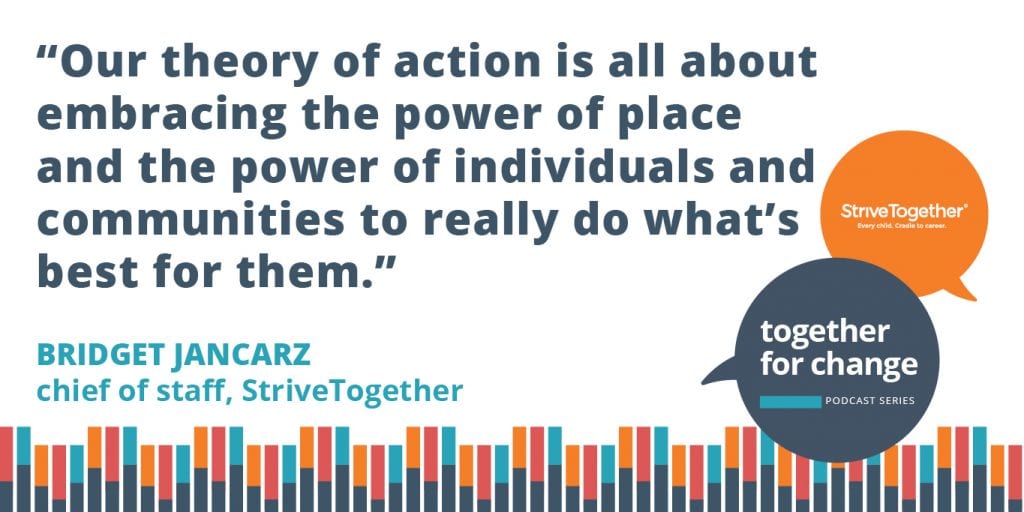
Bridget Jancarz
[12:37] We know that our theory of action actually works to build this type of, what we call — which is a lot of jargon — but what we call civic infrastructure, that ability for systems within a community to seamlessly respond to the needs of the people in that community. Through a pretty rigorous evaluation, I know Lisandra mentioned the word rigor, we’ve been able to see that this approach works over time. So like I said, I’m not surprised at all that Rocky Mountain Cradle to Career was able to take what they knew and what they can be best in the world at and use it to address this tremendous public health crisis.
Rocky Mountain Cradle to Career had created civic infrastructure ahead of the pandemic. We’ve heard, what they’ve, what they were able to do, and then what they were able to shift to do. And they’ve always been focused on kids and families. And what I love is that, you know, when you’re talking about food insecurity, they didn’t just sit and say, “Well, our lens is only kids and families. This is only what we’re able to do. We’re not going to address the most pertinent needs that folks are facing.”
[13:52] When COVID-19 hit, they didn’t wait for anyone to tell them what they needed to do. They took the power to do what was needed in their community. And that transition, that expansion of the work happened so seamlessly. If I can share just an anecdote, I remember being on the phone with Becky and Lisandra not long after they went into this transition mode, and they were like, check out our website. And okay, sure, great, I go, and the amount of data and the outcomes and results they had already codified and were focusing on was second to none.
And so, you know, one of the key principles in the theory of action is using data, both for evidence-based decision making and continuous improvement. And I love that Rocky Mountain was able to lean into that, to use data to map where there was greatest need, to understand what services were being provided. And I think what’s really special about their work in particular, and something I hope we’re maybe able to touch on, is their ability to weave quantitative data. So, numbers like who’s receiving food, where is there the greatest food need, but also qualitative data. They are the vanguard in really understanding how to take qualitative data, how to take stories and lived experience, and blend that with sort of the typical data we would think about in communities.
[15:28] And so, it’s been just a really impressive transition and expansion to see. And I think that a lot of collective impact initiatives, whether they’re StriveTogether Cradle to Career Network members, or all of the different partnerships or initiatives that are embracing that frame across the country, I think what we see here is that when you’re working rooted in key principles for making change in a community, it doesn’t matter what the challenge or issue is. When you’ve got that set of capabilities and that sound infrastructure, anything is really possible.
Christian Motley
[16:09] That’s a great point, Bridget and again, what I hear — I want to make sure, to your point, that we talk to Becky and Lisanda about their use of data, the qualitative and the quantitative piece. I caught that earlier. And I want to ask you both, just what have you learned about the impact of being able to match those two categories of data in your community to be able to support the stabilization effort?
Lisandra Gonzales
[16:36] Well, we get closer to the root cause faster when we look at voice and perspective every step of the way. And we just really have made it a hard fast rule. Great. We’ve got the data, we need the data, we disaggregate the data, we drop it on maps, we see where the opportunities are, then we go deep in those areas and hear from the people who are being impacted by those systems about what really is happening and then that crop, you know, we triangulate all of that information before we support any partner to be thinking about any solution. We cannot continue to build or rebuild systems without consulting those that the systems are designed to impact. We just follow that rule.
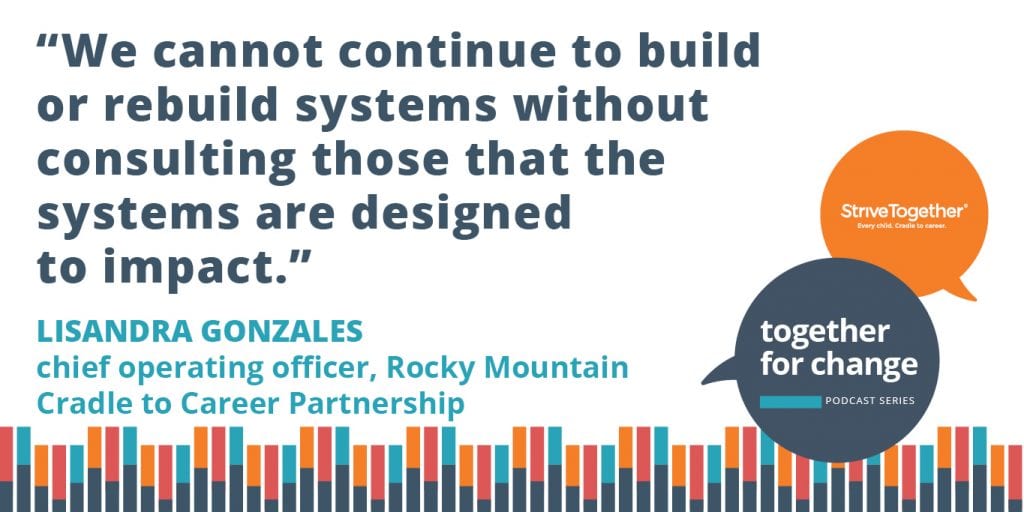
Christian Motley
[17:17] I live in Kentucky. We used to have an education commissioner who used to talk about using data as a flashlight and not a hammer. And I think that’s exactly what you all are doing there. And I think, you know, if you are really looking at the data, that oftentimes if you are pulling out race, for example, you can find some disparities there.
And the question I want to ask is, you know, what role did race play in the work that you all were doing at home? What was the impact of race and ethnicity in decision making, for example? Were you able to use the data? What information were you gleaning, what conversations were being had on the ground?
Lisandra Gonzales
[18:05] Well, for sure, and primarily, mostly because of the initial onset, our numbers were spiking because of the racial demographic we have in Adams County. And so, we’re a hotspot in Colorado because of the demographic that we have, which is strongly growing Latinx population, working class, etc., high undocumented population.
And so that really put us in a position where we had no choice as a community but to really think about why is it that numbers are skyrocketing for this, populations of color in particular. But I have to say that you know, setting that aside, we are so incredibly fortunate. We would not be in the position that we are now had it not been for the Board of County Commissioners that are elected in Adams County, because they are the most of selfless set of leaders that I’ve ever had the opportunity to experience. They really set aside this idea of like, what work do we want to do to, what work needs to get done for the populations that need it most, and really pushed on some systems changes to ensure that people of color, in particular undocumented individuals, have equal access to testing and to health care.
[19:25] And so, I think just the positioning of those two things, the right leadership in place, thankfully in our community — because it’s not like that across the U.S. and at the national level — that was in our favor. And then in addition to that, it was this glaring need to focus on where that flashlight was pointing to the greatest opportunity. So those two things I think catapulted us from really being a community that didn’t ever talk about systemic racism to one that now has put that at the forefront.
Becky Hoffman
[19:56] We endearingly say we double dog dared them to double down and to not let up.
Which is a good segue is, in the meantime, we’ve spent the last couple of months releasing a new strategic plan. And this new strategic plan — I don’t even want to call it new, it’s the natural evolution of where the community was ready and responding to the twin pandemics that are in front of us. And so racial equity is called out on the first line. We are no longer asking for permission or being patient. We are calling that front. We’re calling that out front and center.
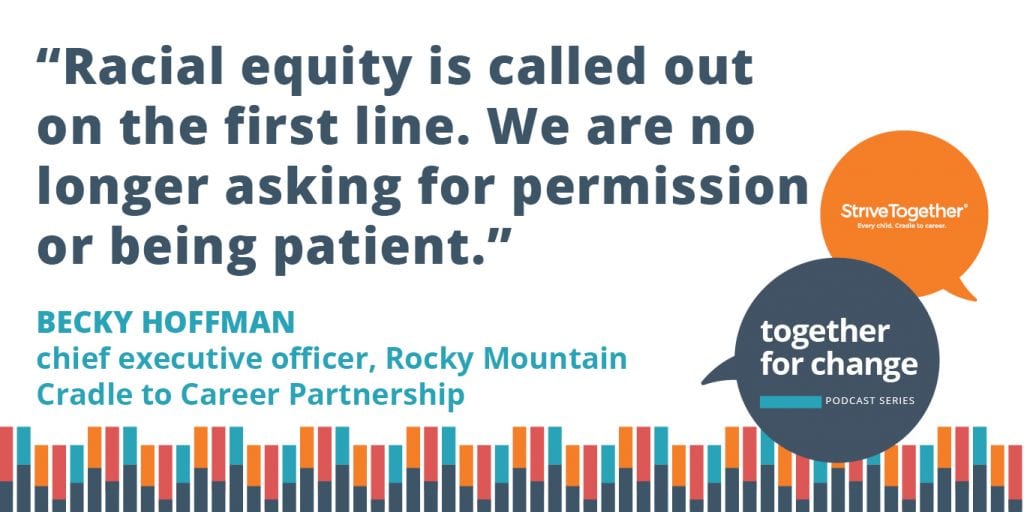
Christian Motley
[20:35] I wonder what you found in the stabilization effort that you think is important to be able to sustain moving forward. Are there any adjustments that you all made in your system, that you all made with your community partners, or that policymakers are even looking at to say, okay, this is an adjustment that we made to meet the moment. But you know, what can we do? What is a good idea that we can’t leave off the table moving forward?
Becky Hoffman
[21:00] I think the tricky thing with this work is that it makes radical common sense. And on paper, people can buy into the idea and concept of what we are talking about working together towards outcomes. The quick wins and harnessing the momentum that we’ve had in the community has given the hope that we don’t have to stay here, and we can keep looking at the future and we can keep positioning ourselves for success.
The action needed is clear, and quite frankly, it has been for many years. The biggest takeaway is that leaders need to continually be bold. They need to be decisive and they need to be hyper-focused on outcomes.
Lisandra Gonzales
[21:42] I think the other piece of that is the face of leadership has to change. We need to ensure that the leaders in our community are reflective of the demographic in our community, and that folks who had informal authority are stepping into spaces where formal authority is abundant and working shoulder to shoulder to develop the systems moving forward.
And so, one of the things that we did almost immediately, is we worked to identify a baseline of what number of authentic representation did we have on those response and recovery teams? And then what did we need to do to ensure that those voices were not just lifted through qualitative data. but in those sessions, which, unfortunately, were via Zoom. And so we were thinking about like, how do we ensure that we have the technology devices out there, the ability to interact with folks with different languages etc., to ensure that they could be in the sessions and contributing and that they were primed and supported for that, and that we were not holding those sessions the way we would formally hold them before.
[22:46] And that’s just one step in the right direction. And now what we’re seeing that I think is carrying forward is community members who’ve done this work on their own for a long time are now saying, we got to make sure that that is included every step of the way. How do we ensure that we have those voices continuously alongside us, all the way to our highest level of community-level leadership tables? So, I think that’s one. I think the second is that we’re not going to go at it alone anymore. And I say “we” as the backbone supporting this community.
We’re hearing the word we way more than we have ever heard. And don’t get me wrong, it’s not Nirvana here. You’ll come on the ground and there’s still a lot of fear of funding and how are people going to keep their doors open, nonprofits, etc. But we’re seeing an incredible shift to we are not going to operate in silos. We have got to move together moving forward, instead of deciding something on my own, I want to come to the table where everyone, or the majority of people, can come and figure things out.
Becky Hoffman
[23:48] The regional collaboration and cooperation, folks don’t have a choice anymore. And so, we were already starting to hear the word “we” a lot more instead of our kids, my kids, my city, right? We’re now starting to hear things like “Well, we’re not going to get there as a region if we keep showing up that way.” And we are really fostering and supporting our leaders to be confident to know that by utilizing the data, by utilizing the voice of the folks most impacted, that we will be able to get there.
Lisandra Gonzales
[24:23] Where we’ve landed as a community is our network has always been focused on economic and social mobility for young people. And those seven cradle-to-career outcomes continue to be critical to our community. For us, they’re synonymous with economic, economic development, economic mobility. But what we’ve done is we’ve broadened the focus of the cradle to career, the Rocky Mountain partnership, to four larger outcome areas that really are going to be thinking about data, keeping a finger on the pulse of the community from a multi-generational approach.
We’ve identified that if we really are going to impact third-grade reading scores, then parents of third graders also have to have strategies and systems impacts to best support that family, for young people to be able to be okay and to thrive. And so that’s, I think, one of the biggest things that’s resulted from our work in the pandemic space. I think the second thing is again, that real critical focus on lifting the kind of silent leaders from our community, providing them a voice and amplifying their involvement.
Christian Motley
[25:36] That’s right. And, you know, Bridget, I wonder — so we’re hearing this powerful example, out of Colorado. And I wonder, you know, is this is this aligned with what you’re hearing in other communities and what themes are you seeing just across the Network?
Bridget Jancarz
[25:50] So, this is the beautiful thing about being privy to a network is that there are so many commonalities, and yet the way the work transpires is different. I think about these grounding principles: advancing equity, leveraging resources, using data, and so many communities are doing that. But each of the stories is different. And I think that’s what makes this work so exciting and powerful.
But absolutely, there are common themes, and I was struck by one of the things Lisandra mentioned, about who sits in power and who makes decisions. Yesterday I was reading a blog on Board Source, which is a pretty common nonprofit thought leader on governance and boards in the nonprofit sector, and it was talking about the need for shifts in power and governance.
And one of the quotes I was really struck by was the fact that we use community members as informants often in our work, but we don’t believe that they’re actual changemakers or decision makers. And I think that’s something that’s coming through as a top priority and a top need for change.
[27:16] I think about South King County, South Seattle all the way to Rochester, New York, and this is really bubbling up, there’s this need to shift power and not do so at a surface level or a tokenizing level, but to really authentically change the way that decisions are made, that resources are distributed, that people are able to take charge and voice what they need and what their hopes and dreams are for their community.
And I think that is a really, really powerful thing. I predict that we’ll see in the philanthropic and social sectors a lot about shifting power. What I think is going to be so key here is for communities like Rocky Mountain to actually show the country and the world what it looks like to actually activate on it — not just talk about shifting power, but actually making that a reality.
[28:20] The other thing that I think is a really common theme is this need to zoom out and look at the systems level. Not just, you know, 30 students here, 50 families there, but what is the actual ecosystem in a community? And I know many initiatives in the social sector may focus on one system, one outcome area, like education or health or housing. And I think if, you know, a public health crisis, economic crisis and racial justice awakening happening all at the same time have taught us anything, it’s that change has to happen at a systemic level. And that those systems are inherently interconnected.
You can’t talk about education without talking about public policy, about government, about housing. You can’t talk about health without talking about human services. And so this idea of needing to not only recognize the systems that are at play here, but then actually figure out how to convene and coordinate and make those systems talk to one another is an incredibly, incredibly important trait of this work.
And one that I think again, we’re seeing. I think of, you know, our friends in Memphis, who are really zooming out, looking at systems, thinking about how housing impacts children in the early childhood space, in K-12 space, but then how does housing impact someone who’s also trying to hold down employment? And Lisandra, I think you mentioned that multi-gen approach. You know, you can’t just look at and you can’t only look at downstream pieces.
[30:18] I know we had a podcast where our friend Dan Heath talked about his new book, Upstream, and all about upstream investment and upstream thinking, and I think to do that, you have to be thinking multi-gen or two-gen. And so those are themes that we’re seeing across the country.
Lisandra Gonzales
[30:38] Some could ask, is this an attempt to boil the ocean? No. It really is how do we look and understand on the pulse of the community, overall health of the community, to then identify where there are opportunities for collective work to happen to have impact. And then that starts to change the way the community works together. It’s the most — the biggest systems change that happens is when that community starts to work together differently towards common goals.
Becky Hoffman
[31:09] Add that it feels like the role of the backbone is similar to being in a circus act. And like you’re spinning the plates, and you have to spin all the plates and if one drops, then the whole thing falls apart. And I — the biggest word and term that I think our team and our leaders is coming out of this is Bridget’s word around interconnectedness. And we think about interconnectedness of the data, right? We are no longer in this community going to hide behind just social-economic data, we have to cross-walk that with race, we have to cross that with how our LGBTQ kids are showing up, how our foster care kids — it all plays in together.
And then at the systems level, the way we have been talking about that is really what is that warm handoff from the education sector to the housing sector, to the food security sector, right. Everyone has a role as we think about social and economic mobility.
Christian Motley
[32:04] And one thing I want to make sure that we capture is that, you know, I referenced Adams County earlier. But you know, given the work that you all have done over the course of years, you now have seen interest from surrounding communities, right? And so, you went from Adams County to Rocky Mountain because there are other communities that were interested in doing this work as well, right?
Becky Hoffman
[32:27] Yeah, we want to give a shout out to our friends at the city and county of Broomfield that formally joined the partnership at the beginning of this year. And we are getting inquiries from other surrounding communities that really want to be at this table and see the secret sauce is the only sauce that is going to get us positioned for what we need to out of these two twin pandemics.
Christian Motley
[32:50] As communities are taking up this work to address these, really these twin pandemics, what would you call on community leaders, policy leaders, you know, folks who really want to contribute to this effort. I mean, what would you call on them to do?
Becky Hoffman
[33:06] I have two big takeaways and I’ll kind of talk about it from the micro to the macro, but the action needed is clear. And, quite frankly, has been for years. And it is now time for leaders to be bold, decisive and focused on outcomes. And the third one, which we’ve mentioned the numerous times, is we are no longer able to hide behind social economic data.
And so, with that, you know, the problems that we are experiencing are complex. The interconnectivity of these problems are complex, but the solutions are not.
[33:38] The “what” is well studied, researched, tested and documented. We know what to do in order to get ourselves positioned for true success. The “how” is the theory of action, it’s the secret sauce to systems change. Thanks to StriveTogether, we have numerous examples of individual, organizational, sector-level change management. And we just need to keep going and supporting our decision makers and our community leaders to continually understand, listen and actively respond to the community, and then align the resources in the policy that it needs to take to move there.
As a white leader, I want to be vulnerable and share that there’s a time to lean back and there’s a time to lean in. And I personally have shown up a little paralyzed and knowing the difference of the two. And what I would say moving forward is that there are often times in this gig that you go sideways or there’s a pit in your stomach or something goes unsaid, or the inequalities are not addressed in a way that is honoring of the folks that shared that. And really, that’s not good enough anymore.
And so, my call to action for myself and for our community is to really lean into equity inclusion as a verb. And we need to show up, and we need to be bold, and we need to be diligent. And really, quite frankly, this is the time to be impatient for those changes. We really need to keep harnessing the momentum that is here and to keep going.
Lisandra Gonzales
[35:11] We have to shift power. We really need to just have to have the courage to shift the power and put the community in a place where they’re co-developing what this community is going to look like today, tomorrow and moving forward.
There’s a lot of effort going around or call for kindness. And it’s not that I don’t agree that kindness is needed in the world. But we need a lot of courage and tenacity and fearlessness, fierceness. I’ll add that in there as well. We can’t keep doing this. We got to change the dynamics of power.
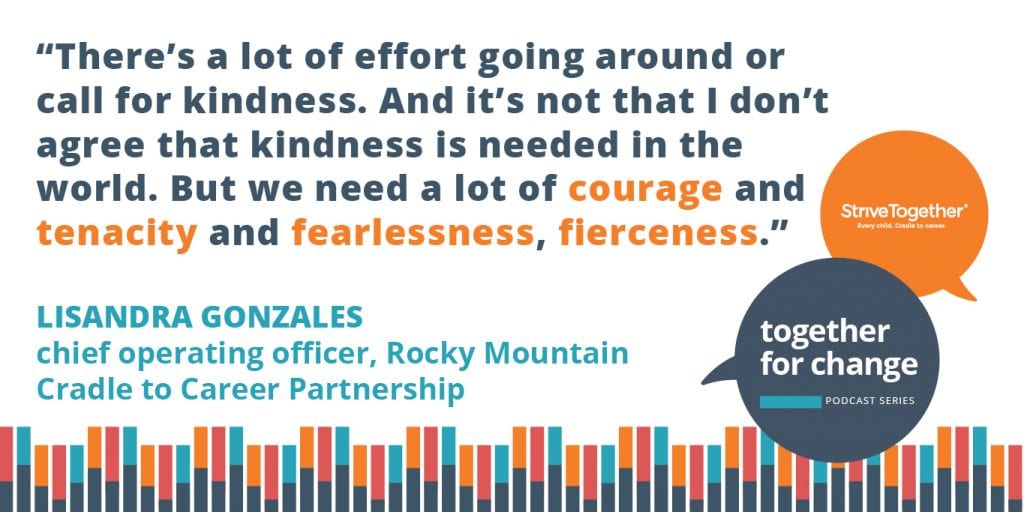
Christian Motley
[35:43] And Bridget, wrap us up — what would you call on leaders to do?
Bridget Jancarz
[35:48] Don’t be afraid to name and tackle what’s real. We are facing huge challenges right now — things like structural racism, police brutality, white privilege, immense racial disparities. We’re past the point of being polite about those. So, what Lisandra said about courage — that’s real. So, we have to name it, we have to hold it center. And I think what you can learn from a community like Rocky Mountain Cradle to Career is that you should trust yourself and trust what you know.
Wisdom and solutions lie in place and lie with the people who make up place in community. And I think a lot of people when, you know, major challenges arise, look for outside solutions, look for some type of silver bullet. And the silver bullet is actually the people who make up place. So, leaders at all levels community members at all levels. Trust yourself, trust what you know, trust the lived experience of people who are actually part of an ecosystem.
[37:00] I think the last thing I would say, we have to center our response in humanity, and not the challenges that we’re facing. So if I could leave you with a visual, if you were thinking about how to come out of a pandemic, with a racially equitable recovery, or how to turn systemic racism on its head — when you’re thinking about the solution, what’s at the center of that? Is it a system, an institution, or is it a person? Is it a child, a family, a community member, the guiding force that you’re organizing around, or is it a traditional institution? And if you can say that you’re really organized around our shared humanity, I think we’re in for some pretty radical transformation.
Christian Motley
[37:56] And that’s the last word. Lisandra, Becky, Bridget, thank you for joining us. I appreciate you all.
For folks who are listening, listen, stay connected by visiting us at StriveTogether.org. You can find the transcripts of Together for Change and learn more about upcoming events like our annual Cradle to Career Convening. Thank you, everybody.
Listen to more episodes and subscribe >>

